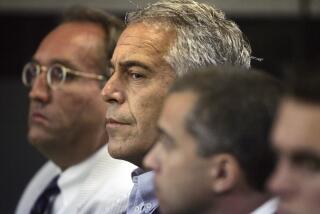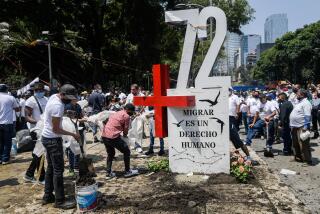Floridians Ordered to Flee as Hurricane Floyd Nears
- Share via
MIAMI — More than 1 million residents of Florida’s east coast were ordered to evacuate their homes and move inland Monday as Hurricane Floyd moved westward toward the U.S. with what forecasters described as catastrophic-force winds.
With winds of 155 miles an hour, Floyd has the potential to be one of the most powerful hurricanes ever to strike the U.S. Landfall could come as soon as Wednesday, forecasters said, anywhere along 400 miles of coastline, from South Florida to Georgia.
Hurricane warnings were posted from Miami to Brunswick, Ga. A hurricane watch was in effect through the Carolina coast.
Floyd was described as a monstrous, 500-mile-wide system, with hurricane-force winds extending 100 miles from its center. “It’s scary. It’s very scary,” said Gov. Jeb Bush, who declared a state of emergency, giving him authority to deploy the National Guard if necessary.
As the storm edged into the central Bahamas at nightfall, winds picked up in Nassau, the island nation’s capital, sending residents into frenzied preparations while tourists scrambled to get out. But it was too late for most.
“It was absolute chaos,” said Rebecca Kane, 27, a visitor from Luton, England, who returned to her hotel from the international airport after being unable to get on an overbooked flight off the island of New Providence. “I called my mom and told her we were on the way home. But we’re not.”
American visitors in the Bahamas were informed by printed handouts from the U.S. Embassy that government personnel had been authorized to leave.
Guests at the 700-room Radisson Cable Beach Resort were advised to pack their suitcases, then put their suitcases into plastic bags handed out by hotel staffers. If necessary, guests were told, they would be ordered to leave their rooms and gather in the ballroom on a side of the hotel away from the sea.
“I’m sure they built this place up to be prepared for this kind of stuff,” Lance Neely, 23, a Madison, Wis., honeymooner, said hopefully, looking at Tiwana, his bride of three days. “At least we got to go down the water slide today.”
At 11 p.m. EDT, Floyd was 360 miles east-southeast of Miami. The hurricane was moving slightly north of due west near 14 mph with top winds of 155 mph--just below Category 5 strength.
Forecasters predicted that Floyd would turn northwest, possibly sparing Miami and other parts of South Florida.
Although the first signs of the storm were not expected in Florida before today, news of its approach sent tens of thousands of people home from work early and into stores for emergency supplies, such as food, water and plywood for boarding up windows. Motorists wanting to fill gas tanks caused traffic jams at service stations.
“This storm is simply too close for comfort,” said Miami-Dade County Mayor Alex Penelas in issuing mandatory evacuations affecting about 270,000 residents of greater Miami. “This is going to cut so close to the coast, we can’t risk it not turning.”
On Miami Beach, a barrier island and prime tourist destination, hotels were busing guests to the mainland side of Biscayne Bay. Along Ocean Drive, many restaurants and shops were boarded up.
In the Miami area, 21 emergency shelters were opened Monday. An estimated 1,000 people, many transported by public buses, had reported to shelters by evening.
Schools throughout the state canceled classes scheduled for today. Storm shelters were opened, and residents of low-lying areas and mobile homes were ordered to pack up and leave.
United Airlines said it would discontinue all flights to and from South Florida as of early Tuesday.
At Walt Disney World in Orlando, officials said that they, like other inland hoteliers, were busy taking reservations from coastal residents seeking inland shelter.
Forecasters admitted that the rapid intensification of Hurricane Floyd into a major system was unexpected. “This is a real surprise for us,” National Hurricane Center director Jerry Jarrell said.
At Cape Canaveral, NASA planned to close the Kennedy Space Center by midnight after securing all four space shuttles in hangars. Left stranded on their launching pads at Cape Canaveral Air Station, however, were four rockets worth $680 million. Officials said they didn’t have enough time to roll them in.
South of the cape, military aircraft at Patrick Air Force Base were flown to other bases away from the coast. Cruise ships in ports from Miami to Jacksonville prepared to weigh anchors.
According to Max Mayfield, deputy director of the hurricane center in Miami, most forecasts generated by computers indicated that Hurricane Floyd would turn northward after passing through the Bahamas sometime today, and could make landfall Wednesday somewhere between Charleston, S.C., and North Carolina’s Outer Banks.
But Mayfield also warned that Floyd was “so large and so powerful” that it could override other atmospheric influences and flummox both computers and human forecasters.
“You just can’t bet on that perfect forecast,” Mayfield said. “The wise thing to do is pray for the best and prepare for the worst.”
Hurricane Floyd, the sixth storm of the six-month hurricane season, formed from a wave of low pressure that moved off the coast of Africa early last week. It skirted north of the Leeward Islands, lashed Puerto Rico with heavy rain, then ballooned into a major hurricane as it rolled toward the Bahamas.
With its central barometric pressure dropping, and cyclonic winds wrapping tightly around its eye, Floyd grew into a storm even more powerful than Hurricane Andrew, which struck South Florida with 145-mph winds in 1992. Andrew was blamed for about 20 deaths and about $30 billion in damage.
For many of those who went through Hurricane Andrew, word that Floyd was an even more powerful storm was cause for anxiety and action.
“We put all the shutters on, brought in all the toys and furniture from outside, and filled up jugs with water,” said Kim Pou, who organized the preparedness efforts of her husband, Alfredo, and their three sons in South Miami. “And I’ve got all my important papers together just in case we have to leave in a hurry.”
The prospect that Floyd could veer away from Miami did not assuage Pou’s fears. “Even if it doesn’t hit us directly, we’re going to feel some wind,” she said. “We have several avocado trees, and we’ve had one branch and about 100 avocados come down already.”
A critical moment in the life of Hurricane Floyd and those in its path was expected this evening when the eye is predicted to pass through the northwest Bahamas. A jog to the north could keep the storm off the Florida coast, and the Sunshine State would feel the winds of the storm’s eastern, weaker side.
Should the storm not be picked up by an approaching trough of low pressure, however, the hurricane could cross the coast with winds capable of destroying homes, uprooting large trees and producing a storm surge of up to 20 feet.
Well out in the Atlantic Ocean, Hurricane Gert, with top sustained winds of 75 mph, was following a track similar to that of Floyd.
Clary reported from Miami; Stanley from Nassau. Also contributing to this story was Times researcher Anna M. Virtue.
For Hurricane Floyd updates, go to The Times’ Web site: https://www.latimes.com
More to Read
Sign up for Essential California
The most important California stories and recommendations in your inbox every morning.
You may occasionally receive promotional content from the Los Angeles Times.













